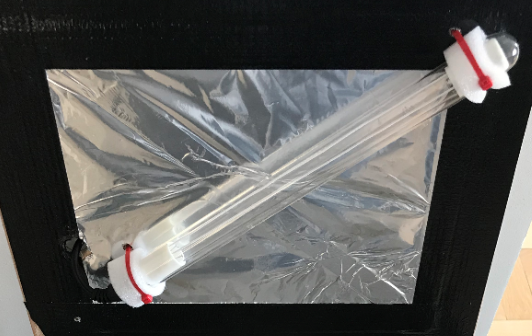The germicidal capacity of UVC light has been known and exploited in industry and research for a long time. UVC light (with a wavelength between 200 nm and 300 nm) is strongly absorbed by nucleic acids, causing photochemical alterations of the genetic material of microbes —such as pyrimidine dimers—.These alterations hinder the replication of the genetic material and/or the expression of vital proteins, killing or inactivating the germs.

Single-stranded RNA (ssRNA) viruses, such as SARS-CoV-2, are particularly vulnerable to UVC irradiation, requiring a dosage of ~2-5 mJ/cm2 (3). Most commercially available UVC light-bulbs are capable of providing the necessary dosage in relatively short times. However, some important technical considerations must be taken into account during the design of a UV germicidal device.
The UV dosage is the product between the intensity (mW/cm2) and the exposure time (s). Hence, it depends on the power of the light-bulb, the surface of exposure, and the time. The exposure surface itself depends on the shape of the light-bulb and the distance from the sample to the emission source.
We used a cylindrical light-bulb ~27 cm long, with a power of 11 W in UVC, placed at a distance of ~11 cm from the target samples. This gives a theoretical intensity of ~5,9 mW/cm2, rendering a needed exposure time of ~0,85 s to deliver the required energy to inactivate the virus (~5 mJ/cm2). However, some details must be considered when establishing a safe time of exposure. First, the light intensity is not homogeneous across the whole light-bulb; near the ends, it decreases down to a value of ~1/3 of the intensity in the center (4). This would increase the needed time at least three times, up to ~2,5 s. Moreover and more importantly, other factors —such as interactions between the light and the materials of the masks, absorption of some of the light by the coating of the light-bulb, end of lamp life, and loss of line-of-sight exposure of the sample—could alter the actual dosage that the sample is receiving. These factors are usually hard to calculate and would definitely entail a higher exposure time for safe disinfection protocols.
Due to the novelty of SARS-CoV-2, there are no specific studies about UV germicidal action on this strain since we reviewed it. However, literature reports regarding UV disinfection of SARS-CoV—the strain that caused the 2002-2004 outbreak—are a good guide in this matter, given the closeness between these two strains and confirmed reports of similar stability (5). The four most relevant studies that we considered report complete inactivation (or close to complete inactivation) of the virus after exposure times as short as 2 min using high intensities, and as long as 60 min using low intensities. These studies report that dosages proven to work against the virus are ~120 mJ/cm2 (6), ~324 mJ/cm2 (7), ~613 mJ/cm2 (8) and ~4800 mJ/cm2 (9). After calculating for the specifications of our device we obtain needed exposure times of ~20 s, ~55 s, ~2 min, and ~14 min—respectively—.It can be noticed that the exposure times of these studies are as much as two orders higher than our initial theoretical calculations, and it is also noteworthy that these studies had trustable ways of measuring intensities and usually worked with liquid samples—which are better media for UV disinfection than the materials of the face mask—For all of the above and the fact that one of the studies reported that SARS-CoV exhibits a relative tolerance to UV light, we decided to use an exposure time of 30 min for the disinfection protocol associated with our device. This time of exposure will deliver an energy about three orders higher than our theoretical needed value (~3,6 J/cm2), most likely eliminating all or almost all infectivity.
Bibliography
- Centers for Disease Control and Prevention. Atlanta, GA: U.S. Department of Health and Human Services C for DC and P. CDC - Recommended Guidance for Extended Use and Limited Reuse of N95 Filtering Facepiece Respirators in Healthcare Settings - NIOSH Workplace Safety and Health Topic [Internet]. 2019 [cited 2020 Apr 2]. Available from: https://www.cdc.gov/niosh/topics/hcwcontrols/recommendedguidanceextuse.html
- Chin A, Chu J, Perera M, Hui K, Yen H-L, Chan M, et al. Stability of SARS-CoV-2 in different environmental conditions. medRxiv. 2020 Mar 27;2020.03.15.20036673.
- Tseng C-C, Li C-S. Inactivation of Viruses on Surfaces by Ultraviolet Germicidal Irradiation. J Occup Environ Hyg [Internet]. 2007 Apr 23 [cited 2020 Apr 2];4(6):400–5. Available from: http://www.tandfonline.com/doi/abs/10.1080/15459620701329012
- Hackerfarm. HOWTO: NUKEMETER – Measuring UV-C Light Intensity. 2020; Available from: https://hackerfarm.jp/2020/03/nukemeter/
- van Doremalen N, Bushmaker T, Morris DH, Holbrook MG, Gamble A, Williamson BN, et al. Aerosol and Surface Stability of SARS-CoV-2 as Compared with SARS-CoV-1. N Engl J Med [Internet]. 2020 Mar 17 [cited 2020 Apr 2];NEJMc2004973. Available from: http://www.ncbi.nlm.nih.gov/pubmed/32182409
- Kariwa H, Fujii N, Takashima I. Inactivation of SARS coronavirus by means of povidone-iodine, physical conditions, and chemical reagents. Vol. 52, Jpn. J. Vet. Res. 2004.
- Duan SM, Zhao XS, Wen RF, Huang JJ, Pi GH, Zhang SX, et al. Stability of SARS Coronavirus in Human Specimens and Environment and Its Sensitivity to Heating and UV Irradiation. Biomed Environ Sci. 2003 Sep 1;16(3):246–55.
- Darnell MER, Subbarao K, Feinstone SM, Taylor DR. Inactivation of the coronavirus that induces severe acute respiratory syndrome, SARS-CoV. J Virol Methods. 2004 Oct 1;121(1):85–91.
- Ansaldi F, Durando P, Sticchi L, Gasparini R. SARS-CoV, influenza A and syncitial respiratory virus resistance against common disinfectants and ultraviolet irradiation Occupational Hygiene working group (SItI) View project Big Data in Occupational Medicine View project [Internet]. Article in Journal. 2004 [cited 2020 Apr 2]. Available from: https://www.researchgate.net/publication/267219876
 Sameera Chukkapalli
Sameera Chukkapalli
Discussions
Become a Hackaday.io Member
Create an account to leave a comment. Already have an account? Log In.